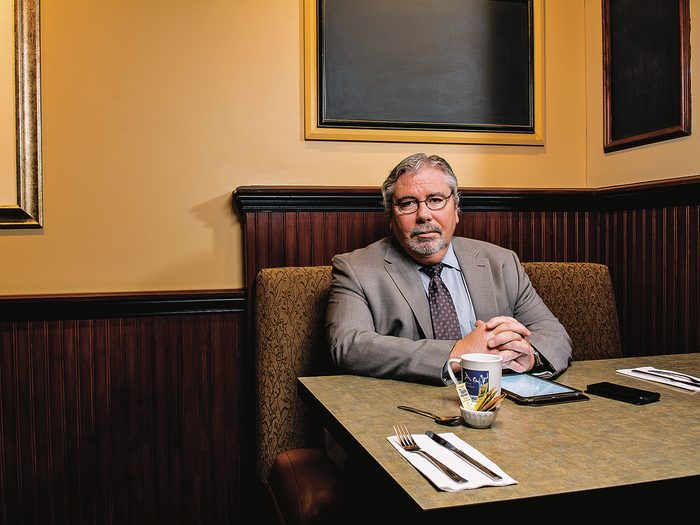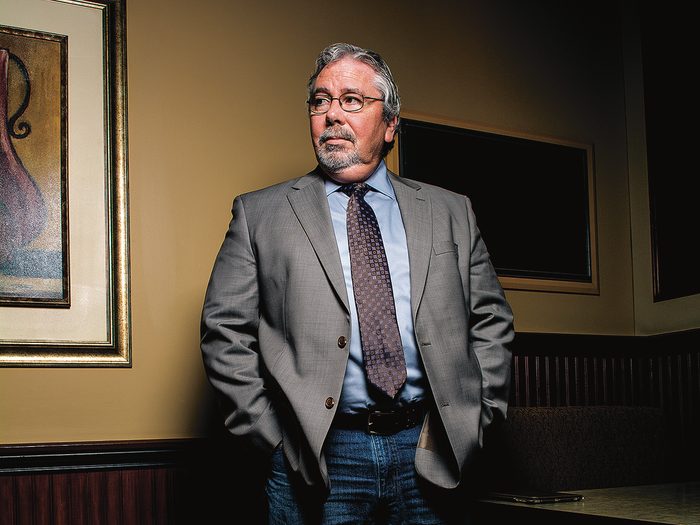
The Disappearance of Kimberly McAndrew
(Editor’s note: This story remains unchanged from its original text, first published in Reader’s Digest Canada in March 2014.)
On Saturday, August 12, 1989, toward the end of Kimberly McAndrew’s quiet shift at the Quinpool Road Canadian Tire in Halifax, her supervisor told her she could leave early. It was Kimberly’s boyfriend’s birthday, so she wasted no time in punching out. At 4:20 p.m., the blond 19-year-old Dalhousie University student, wearing a navy cardigan over an Esprit T-shirt with navy pants, stepped out the store’s back door and began to cross the parking lot. She has been missing since that day.
“Kimberly McAndrew was a pure victim,” says Tom Martin. “She didn’t do anything to deserve this. She was just walking home.” Police refer to unsolved crimes, especially homicides, as “cold cases,” but Martin hates the term. “I think it’s insulting to the families. There’s nothing ‘cold’ about these cases. They just haven’t been solved yet.”
In 2004, Martin—today a private investigator—was assigned to the Halifax cold-case unit and flagged the McAndrew case as one worth re-examining. The original investigation never led to a conviction, and Kimberly’s body was never found. But Martin had a suspicion about who had committed the crime. He went to the case with fresh eyes—reviewing all the evidence and re-interviewing witnesses to find overlooked leads and make new connections. “With a ‘cold case,’ you have to reheat it,” says Martin.
Halifax is one of Canada’s most violent cities. Despite being the 13th largest metropolitan area, in 2011 it had the second highest homicide rate in the country and ranked fourth in 2012. According to a 2008 report by Dalhousie University criminologist Don Clairmont, the city has “a long history of boisterous, sometimes violent, behaviour associated with it being a major port, military centre and government base,” and it’s a known hub for gun- and gang-related homicide. The city’s number of unsolved major crimes, which include murders and disappearances that are presumed to be homicides, is unusually elevated: 75 as of January 2014, the oldest going back to 1955. (The York Regional Police in Ontario are responsible for a population double the size of Halifax and have around 45 unsolved murder cases dating back to 1956.) Worse, the dismal ratio of crime to charges laid means Halifax has one of the lowest homicide clearance rates in the country. The situation is precarious, and Martin is frustrated both by the police department’s lack of commitment to pursuing unsolved crimes and his own inability to give victims’ families a measure of closure.
Soon after Martin began studying the McAndrew case, he re-examined an old lead. Years earlier, Andrew Paul Johnson, a repeat sex offender on probation, had written an essay as part of his treatment program. The psychiatrist noticed that the essay described what sounded like the McAndrew abduction and contacted Halifax police. Johnson, who had a criminal history in Nova Scotia, was by then in British Columbia and had been charged with kidnapping and unlawful confinement. In 1997, Halifax officers, following up on the psychiatrist’s tip, had tried to connect Johnson to Kimberly but dropped the matter due to lack of evidence. By 2001, Johnson had been designated a dangerous offender and imprisoned in B.C.
Once Martin began looking at the case again in 2004, he was struck by two details about Johnson. At the time of Kimberly’s disappearance, Johnson often stayed with his girlfriend in an apartment facing the Canadian Tire parking lot. Secondly, he had been arrested in B.C. with a developmentally disabled 20-year-old woman in his car, and he had made multiple attempts to lure other young women by posing as a plainclothes police officer. In his vehicle, cops say they found a meat cleaver, lubricating gel, packing tape, handcuffs and a police badge.
Martin re-interviewed the family, trying to get an even better understanding of Kimberly. He learned that, having grown up in rural Cape Breton, she was uneasy in urban centres. She disliked going anywhere alone and was unlikely to allow strangers to approach her, let alone get in a car with one. Her family was adamant that she would have screamed and struggled if anyone tried to grab her. However, Martin believes she might have let her guard down with Johnson. “How did the bad guy get her?” he asks. “Her father was a police officer. If Johnson had approached Kim and showed his badge, it’s probably the only way that anyone could have got her into a car.”
During his 30 years on the force, Martin was among Halifax’s top cops. He handled hundreds of major cases and was lead investigator on 25 murders. In 2001, after contributing to the arrests in two murders, an attempted murder and a kidnapping, as well as apprehending a serial sex offender, he was named Police Officer of the Year. His credentials include certification as a hostage negotiator and training in crime-scene analysis and cold-case investigations. He retired in 2008 after suffering three cardiac arrests. That’s when Martin started focusing on more heart-friendly pursuits, like woodcarving, fly-fishing and running the small farm in the Musquodoboit Valley, northeast of Halifax, where he lives with his wife.
Today, Martin, 57, runs a private-investigation firm that does consulting mainly for lawyers. Discreet and affable, he‘s the kind of man who encourages others to do the talking—qualities that helped make him a decorated cop. Occasionally, when families of missing persons ask him to take on their cold cases, he will, so long as he isn’t interfering with a police investigation.
“I think he really feels for the families, including my own, who are trying everything to get answers,” says Kimberly McAndrew’s younger sister, Megan. “A dog with a bone comes to mind when trying to sum up his personality.”
Although 70 per cent of homicides are resolved within the first week, Martin believes opportunities to solve old crimes continually arise. New leads may result in officers being assigned to re-investigate a file on the back burner. Anniversaries or media coverage about similar cases remind the public about an unsolved crime, which may convince witnesses to push past their fears or apathy and come forward. Often those thought to be responsible for unsolved crimes reoffend. “When they’re arrested again, for crimes big or small, you reinterview them, remind them that someone’s still working on that case,” says Martin. “Sooner or later, they’re likely to make a mistake, incriminate themselves.”
None of this will happen if officers assigned to unsolved homicides aren‘t actively pursuing them and police forces aren‘t supporting the effort. According to the U.S. Bureau of Justice Assistance, “Because cold cases can be very labour- and time-intensive and may require innovative investigative techniques, squads are most effective when they consist of investigators who have significant experience.”
One of the reasons Martin is interested in politics—he ran unsuccessfully for Halifax mayor in 2012 and as a Liberal candidate in last fall’s provincial election—is to support justice reforms. The Halifax police department currently has three people on its cold-case unit. The problem is that those three officers can be re-assigned to current cases at any moment—a situation Martin calls a recipe for failure. What the cold-case unit needs, he believes, are full-time, dedicated officers to focus on the extensive case files. Getting to know a case inside and out, he says, can take one officer up to a year.
“My criticism has never been of the officers but of management—the lack of resources, lack of commitment, lack of willingness to follow through,” says Martin. “It’s expensive, but should police departments be run like a business or a public service?”
Delve deeper into Canada’s most baffling unsolved mysteries.

The Murder of Jason MacCullough
Shortly after 2 a.m. on August 28, 1999, on one of those foggy East Coast summer nights, 19-year-old Jason MacCullough was walking home from a party through Big Pinehill Park in north Dartmouth, N.S. A good student, Jason was a junior leader with the local Boys and Girls Club and a member of the Boy Scouts; he planned to start his undergrad that fall. Near the spot where the footpath emerged into a low-income neighbourhood, he was shot at close range in the head.
Martin was appointed lead investigator and eventually identified a potential suspect, but the case never came together. Over time, the leads dried up, new crimes took precedence and the MacCullough murder became a cold case.
Six years later, with Martin working in the cold-case unit, an informant emerged with new facts about the MacCullough murder. Martin and his team re-interviewed people of interest and gradually drew closer to laying charges. Then the new informant was caught in a lie, making him worthless as a courtroom witness. Martin still believed he had a case with the new information he’d assembled, but the deputy chief of police didn’t agree and, in the summer of 2005, wound down the operation.
“That,” says Martin, “was one of the most frustrating moments of my career.”
Last August, Martin sat in Allan MacCullough’s living room, in a middle-class Dartmouth neighbourhood a five-minute drive from the park where his son, Jason, was killed. Allan, a land surveyor, has red hair flecked with grey and a goatee. He went to get a bulging banker’s box filled with photos, media articles and notes related to the case. Frequently staring down at the floor, his voice broke as he struggled to talk about Jason, as though he’d learned about his son’s death the previous week rather than 14 years ago. (His wife, Carolyn, a financial clerk, avoids journalists.) While he said neither of them will discuss how they dealt with their grief or about the pressure the murder exerted on their marriage and on Jason’s younger brother, Scott—”It’s private,” he said, “nobody’s business but our own”—trying to keep the case alive has become a crusade for him.
“Somebody took my boy away, and I don’t know who,” he said quietly. “This has changed our lives forever.”
Would it make a difference if the killer were found? Can there be such a thing as closure in a case like this? “Yes,” said Allan. “To think there may be somebody walking around the streets who got away with it. They would think they could get away with it again. So it’s not just for the families of victims but for future victims and their families.”
Later, driving back to Halifax, Martin reflected on what Allan had said about finding his son’s killer. “I think he’d feel vindicated, a sense of justice having been done. But that will not take the pain away.”
Trying to explain why he’s stayed in touch with family members over so many years, Martin says, “You can’t spend that much time with families in their darkest hours and not form some sort of bond. The MacCulloughs called me many times, voicing their frustration. Out of that forms mutual respect, and out of that respect comes friendship.
“When you feel in your heart that there are answers, when for whatever reason the solutions aren’t being sought, that used to make me very angry. Today I find it more sad than anything else. I have a very strong faith, so I don’t get too caught up feeling sad for the victims, but it‘s a tragedy for those left behind. Kim could have been anyone‘s daughter. Jason could have been anyone‘s son.“
Next, check out 10 Canadian true crime podcasts worth adding to your playlist.